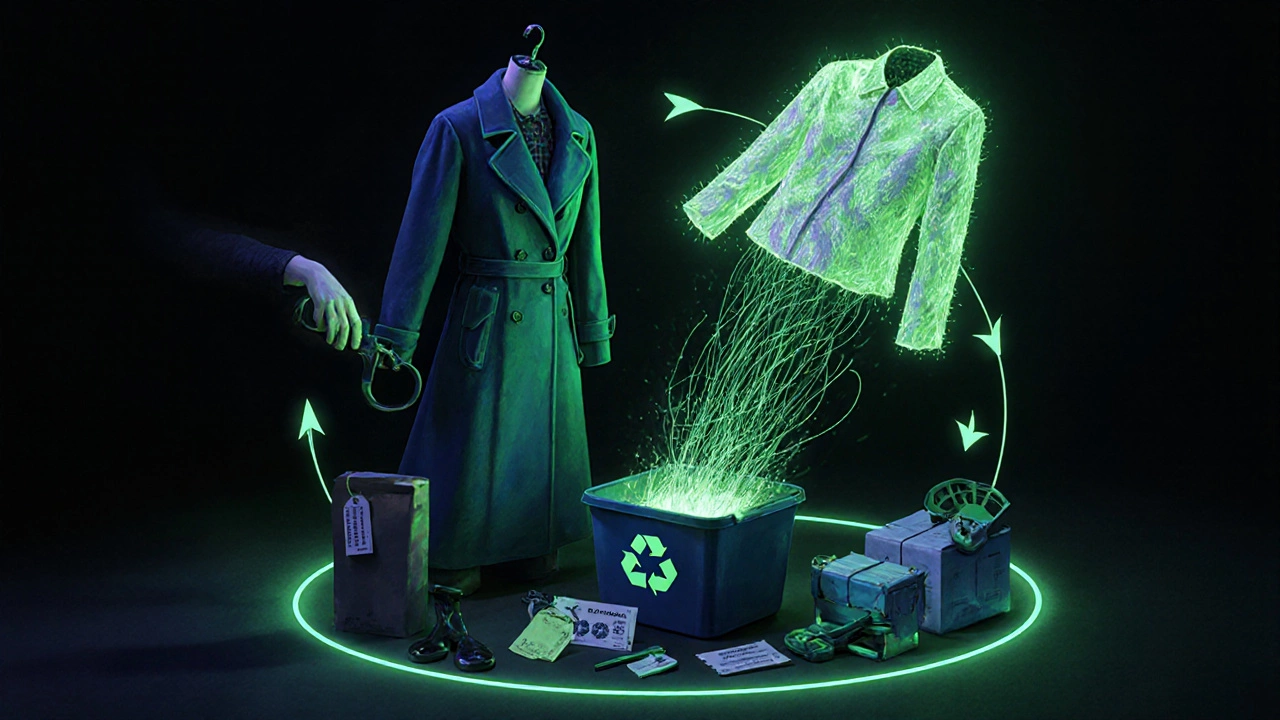Sustainable Fashion Carbon Calculator
Calculate Your Clothing's Environmental Impact
Based on data from the article about sustainable fashion practices
When you buy a T-shirt labeled "sustainable," what are you actually paying for? Not all green claims are real. Some brands slap a leaf on their packaging and call it eco-friendly, while the shirt was made in a factory with polluted water, paid workers less than $2 a day, and shipped halfway across the world. True sustainable fashion isn’t about labels-it’s about what happens before, during, and after the garment is made.
It Starts with Materials
Not all natural fabrics are sustainable. Organic cotton uses less water and no synthetic pesticides than conventional cotton, but it still needs a lot of land and water to grow. Hemp, on the other hand, grows fast, doesn’t need pesticides, and improves soil health. Tencel (lyocell) is made from wood pulp using a closed-loop process that recycles 99% of the solvents. These are real improvements.
Recycled materials are another key piece. Polyester, the most common fabric in fast fashion, comes from oil. But recycled polyester-made from plastic bottles or old clothing-cuts fossil fuel use by up to 60%. Brands like Patagonia and Eileen Fisher have been using it for over a decade. But recycled plastic still sheds microplastics in the wash. That’s why some designers are moving toward natural fibers like organic wool, linen, and Tencel.
Here’s the catch: even the best fabric doesn’t help if it’s dyed with toxic chemicals. Conventional dyeing uses up to 200 tons of water per ton of fabric. Sustainable brands use low-impact dyes, plant-based pigments, or waterless dyeing tech like DyeCoo, which uses CO2 instead of water.
How It’s Made Matters More Than You Think
Two things define ethical production: fair pay and safe conditions. The 2013 Rana Plaza collapse in Bangladesh killed over 1,100 garment workers. That tragedy forced some brands to act, but many still outsource to factories with poor oversight.
Sustainable fashion means transparency. Brands that are serious about ethics publish their factory locations, audit reports, and wage data. Look for certifications like Fair Trade Certified, GOTS (Global Organic Textile Standard), or B Corp. These aren’t perfect, but they’re the best benchmarks we have. GOTS, for example, requires organic fibers, limits chemical use, and mandates fair labor practices across the whole supply chain.
Small-scale production also reduces waste. Fast fashion churns out 100 billion garments a year. Most never sell. Sustainable brands make smaller batches, often on demand. That means less overproduction and fewer clothes ending up in landfills.
Design for Longevity
A sustainable garment isn’t just made well-it’s made to last. That means durable stitching, quality zippers, and timeless cuts. Fast fashion thrives on trends that die in six months. Sustainable fashion designs for years, not seasons.
Think about your favorite jeans. Did they fray at the knees after three washes? Or did they get better with age? Brands like Nudie Jeans and Reformation offer free repairs. Some even give you store credit to return old items for recycling. That’s circular design: keeping clothes in use as long as possible.
Also consider versatility. A well-made blazer that works with jeans, a dress, and a suit is worth more than five cheap ones you wear once. Quality over quantity isn’t a slogan-it’s the math of sustainability. One well-made coat that lasts 10 years has a smaller carbon footprint than five cheap ones bought over the same time.

How It Gets to You
Shipping a T-shirt from China to New Zealand emits about 0.8 kg of CO2. That’s like driving a car 3 kilometers. Local production slashes that. Brands like Kowtow in New Zealand and People Tree in the UK make most of their clothes close to home.
Even packaging counts. Plastic polybags? Out. Compostable mailers made from cornstarch? In. Some brands use recycled paper tags and soy-based ink. These seem small, but when you multiply them by millions of garments, they add up.
What Happens When You’re Done With It
Every year, 92 million tons of clothing end up in landfills. Less than 1% is recycled into new clothes. That’s because most garments are blends-polyester and cotton mixed together. Separating them is hard and expensive.
Sustainable fashion brands tackle this by designing for disassembly. They use mono-materials (like 100% cotton or 100% wool) so clothes can be easily recycled. Some offer take-back programs. Others partner with recycling startups like Renewcell, which turns old cotton into new fiber.
But the best solution? Wear it longer. Repair it. Resell it. Donate it. Swap it. The most sustainable garment is the one you already own.

What Doesn’t Count as Sustainable Fashion
Greenwashing is everywhere. Here’s what to watch out for:
- "Eco-friendly" collection on a brand that makes 1,000 new styles a year.
- "Sustainable" line made in a factory with no labor transparency.
- Recycled polyester that still sheds microplastics and isn’t part of a take-back program.
- "Carbon neutral" claims based on buying offsets instead of reducing emissions.
- Fast fashion brands using "sustainable" as a marketing buzzword while cutting wages.
Ask yourself: Is this brand changing its whole model-or just adding a few green items to keep you buying more?
How to Spot Real Sustainable Fashion
Here’s a simple checklist:
- Does it use organic, recycled, or low-impact materials?
- Is production transparent? Can you find the factory location and worker pay info?
- Is it made in small batches or on demand?
- Does it prioritize durability and repairability?
- Does it have a take-back or recycling program?
- Are certifications like GOTS or Fair Trade clearly displayed?
If you can answer yes to at least four of these, you’re looking at real sustainable fashion.
It’s Not About Perfection
You don’t need to buy only certified sustainable clothes to make a difference. If your current jacket is still in good shape, wear it. Buy secondhand. Mend a tear. Swap with a friend. These actions reduce demand for new resources.
Sustainable fashion isn’t a destination. It’s a habit. It’s choosing quality over quantity, transparency over marketing, and longevity over trends. The goal isn’t to be perfect-it’s to be better than yesterday.
Is organic cotton always sustainable?
Not always. Organic cotton avoids pesticides, but it still uses a lot of water-up to 2,700 liters per T-shirt. It’s better than conventional cotton, but hemp, linen, and Tencel use far less water and improve soil health. Look for brands that combine organic cotton with other low-impact materials.
Are recycled polyester clothes truly sustainable?
They’re better than virgin polyester because they reuse plastic waste and cut fossil fuel use by about 60%. But they still shed microplastics when washed, which pollute oceans. For true sustainability, choose recycled polyester only when it’s part of a take-back program, and pair it with natural fibers when possible.
What’s the difference between slow fashion and sustainable fashion?
Slow fashion focuses on production speed-making fewer, higher-quality pieces over time. Sustainable fashion covers the full lifecycle: materials, labor, emissions, and end-of-life. All slow fashion is usually sustainable, but not all sustainable fashion is slow. A brand could use eco-materials and still mass-produce if it doesn’t control volume.
Can fast fashion brands ever be sustainable?
It’s extremely unlikely. Fast fashion relies on cheap labor, high volume, and rapid turnover. Even if they use recycled materials, their core model creates waste and overconsumption. Some are trying-H&M’s Conscious line, for example-but their scale still drives demand for new resources. Real change means shrinking production, not just swapping fabrics.
How can I tell if a brand is greenwashing?
Look for specifics. If a brand says "eco-friendly" but won’t say where clothes are made, what materials are used, or how workers are paid, it’s likely greenwashing. Check for third-party certifications like GOTS or Fair Trade. Search for news about the brand’s factories. If the only green claims are on Instagram posts, be skeptical.








